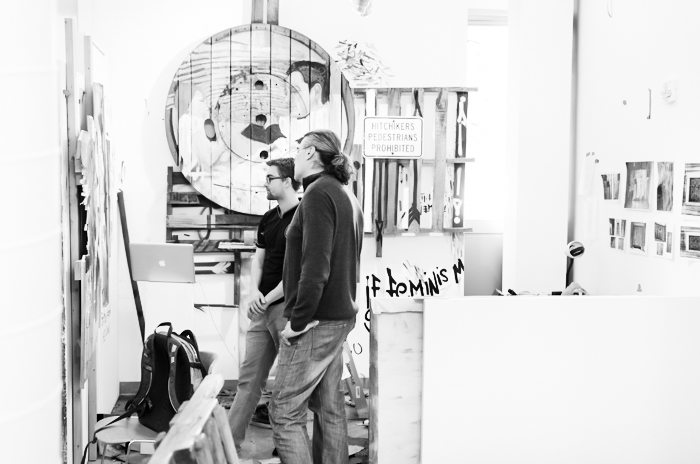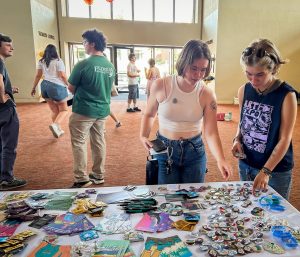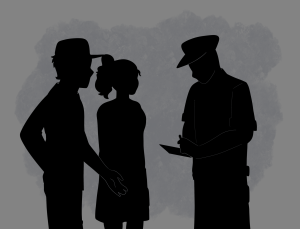Whitman community mourns loss of art professor Rick Martinez

Rick passed away on Jan. 26, 2020. He taught in the art department at Whitman from 2012 to 2020. Photos contributed by Whitman Communications
February 20, 2020
Whitman College Associate Professor of Art Rick Martinez unexpectedly passed away on Jan. 26. Rick was hired in 2012 and promoted to an associate professor in 2016. He also served as the chair of the art department, impacting the lives of many students and faculty throughout his time at Whitman.
Rick was known among the art department faculty for his humor and dedication to his art. Senior Adjunct Assistant Professor of Art Charly Bloomquist recounted attributes of Rick’s character.
“He was real sincere and earnest, and a pretty good conversationalist,” Bloomquist said. “He had a good sense of humor, but it was a subtle sense of humor.”
Bloomquist remembers when the art department faculty had a show at the Sheehan Gallery several years ago, and Rick spoke at the opening.
“I’d never seen him perform in front of a group before, and he was very relaxed and casual and he talked a little bit about himself and his work and then opened it up to questions, and then people asked questions. He was very personal about it, not self-aggrandizing,” Bloomquist said. “He was humble about who he was.”
Bloomquist noted that Rick’s paintings were shown at the Portland Art Museum.
“Museums are kind of a big deal, yet it didn’t make him egotistical,” Bloomquist said.
Associate Professor of Art Nicole Pietrantoni remembers Rick’s dedication to his art and to his teaching.

Associate Professor of Art Rick Martinez gives a senior art major feedback on his thesis in 2015.
“Throughout the time I knew him, he always encouraged me to stay committed to my own art and studio practice — I was always grateful to him for this advice, especially when the demands of academia were pulling us in multiple directions,” Pietrantoni said in an email to The Wire. “Rick reminded me that [at] the end of the day we’re artists and should be creating things in our personal studios so that we can show up and be the artists and teachers we want to be in our classrooms.”
Bloomquist believes that Rick’s teaching style was centered on the individual student and he explained that Rick avoided generalizing his teachings to the group.
“I think it’s better to meet the person where they are at, and help them to the next level, than to have a framework that everybody’s got to fit into. And that was very much his style,” Bloomquist said.
Senior art major Peter Eberle remembers that Rick gave students space in order to learn on an individual basis.
“He liked to give you a lot of room to do your own thing and figure out that you have permission to do your own thing, that you don’t have to follow a program to learn how to paint, that really that the possibilities are endless,” Eberle said.
Senior art major Peter Leyden echoed that thought.
“He was very interested in letting his students discover things for themselves and was just supportive of whatever your skill level or however you showed up to class, he was just going to support you where you were at, and definitely push you sometimes,” Leyden said.
Rick’s own paintings were featured at shows in Houston and San Antonio, Texas, as well as Portland, Oregon. In 2013, he was awarded the Artist Trust Fellowship Grant for Visual Art.
Associate Professor of Art Justin Lincoln emphasized the amount of effort Rick put into his work.
“[The] thing that is really important to understand about his painting is how much time, effort, and energy he put into painting,” Lincoln said.
Eberle would encounter Rick going to work at four or five in the morning in the art building.
“I think the custodian was the first one [here in the morning] and he was the second one here,” Eberle said.
Bloomquist remembers seeing Rick most mornings in the art building.
“I’ll miss him. He did eight o’clock in the morning classes, too. So we’d see each other most mornings and swap stories and tell light-hearted jokes and stuff like that… So that’s where I miss him most, is coming in in the morning and he’s not here.”
Eberle recalls Rick once saying, “Paint like your life depends on it.”
“That’s something that followed for decades. He painted non-stop,” Eberle said.
Rick brought the same work ethic to class with him as well.
“He tried to teach his students how he would like to be an artist, to make art — spending a lot of time in the studio, and consistent dedication and perseverance,” Eberle said.
Rick’s students and colleagues will have the opportunity to commemorate his memory through various memorial efforts, including a book that people can sign at the entrance to the art building, which will be given to his family. In addition, sticky notes and pens were placed outside his office to allow people to post messages onto his door.
The art department community, as well as the wider Whitman and Walla Walla communities, continue to mourn his passing.
“A lot of people would have seen him with his wife, Kim, walking their dogs, Bob and Mike,” Lincoln said. “They walk their dogs all the time. In offering condolences, many times people, especially his neighbors, would mention that, that they miss all of them together.”
Lincoln found that Rick’s own advice offered guidance with his passing.
“When Richard taught abstraction, certain students would struggle with abstraction, and they’d say, ‘ah, abstract painting, I don’t understand this — like, what is this, can you help me?’” Lincoln said. “And he said something along the lines of, ‘it’s not that hard, what you need to do is take whatever is in front of you, whatever you see, and turn it upside down.’”
“Now, especially the first couple of days after his passing, I kind of felt like everything around me had been turned upside down,” he added. “But as an artist, we kind of learn to operate even in a world that looks like or feels like it has been turned upside down.”







Nancy Chávez • Mar 6, 2022 at 12:18 pm
It is with much sadness that I learn about Richard’s passing. I knew him as a fellow undergraduate at Southern Oregon University . He was always very kind to me . My sincerest condolences to his family .
Sincerely,
Nancy Chávez
Victor Hugo Guerrero • Feb 25, 2020 at 1:44 pm
Thank you for posting this article on Mr. Rick Martinez. I had him as an art instructor for three undergraduate painting classes at UTSA- Department of Art and Art History. What an exceptional art teacher. Looking back, I am so grateful to have had Mr. Rick Martinez as a central part of my art education.
So it is with great sadness that I read this article. It has circulated to my desk through email from fellow colleagues her at UTSA that knew Mr. Rick Martinez well, personally and professionally.
My most sincere condolences to Mr. Rick Martinez’s family as the we lost a true and exceptional human being, educator, and artist.
Victor Hugo Guerrero
Senior Administrative Associate, and
The University of Texas at San Antonio, Office of the President,
University Excellence Award Recipient
College of Liberal & Fine Arts
Department of Art & Art History 4.01.06A
One UTSA Circle
San Antonio, TX. 78249-1644
(210) 458-6452 voice
(210) 458-4356 fax
[email protected]
[email protected]